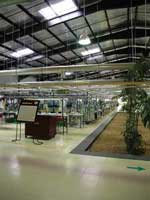Factory goes green
What trigger is the company responding to?
M&S found that their customers expected them to address their environmental impact as part of 'business as usual' operations. This meant committing to work with their suppliers to combat climate change, reduce waste and safeguard natural resources.
What was the response?
A reduction of carbon emissions by 80%, an energy saving of 46%, a reduction of water consumption by 58% and zero solid waste to landfill has been achieved.
 Tarred roads have been replaced with paving blocks to greatly reduce heat build up around the factory, which in turn prevents heat flow into the factory and helps save on air conditioning.
Tarred roads have been replaced with paving blocks to greatly reduce heat build up around the factory, which in turn prevents heat flow into the factory and helps save on air conditioning.- The building management system is an intelligent control center that controls carbon dioxide and humidity levels in the modern air conditioning system ensuring an optimum working environment.
- The use of natural light is critical to lowering heat and reducing energy consumption. The windows use special glass material channelling sunlight into the plant's workspaces, without the accompanying heat. LEDs provide light to the sewing machines at needle point, supplementing the natural light provided by the skylights. This has helped to reduce total electricity consumption by 10%.
- The factory's steam boilers and steam distribution systems have been redesigned and a brand new super-efficient air conditioning system installed. All of these modifications have reduced total energy consumption by 46%.
- The green areas in the gardens have been increased substantially. The plant's new rainwater percolation pits allow water to soak back into the ground helping to replenish the natural water table. The plant's roof has been redesigned to harvest rainwater, collecting about 115 cubic meters per day, which is recycled for all use except drinking water. Subsequently, a tertiary filtration system and a disinfection process allow the used water to be recycled again for toilet flushing and gardening. The overall result is a reduction of 58% in total water consumption.
- An electrically-powered car is used for delivery of samples between plants and for short haul of stock within the factory, sourcing its energy from the plant's windmill.
- The factory recycles and reuses 100% of the solid waste produced. Even canteen waste is composted to contribute to biogas generation. This biogas is then used to power the gas burners in the kitchens.
Bottom line benefits
- 30%-40% reduction in operating costs
- Heath and safety of building occupants
- Enhanced occupant comfort
Wider lessons
The adoption of best practices and global standards has not only benefited Brandix qualitatively, but has also brought a considerable benefit to both top and bottom line performance, through effective cost and waste management and higher productivity.
Case study sources
Case study provided by Lloyd Fernando
http://www.brandix.com/
http://corporate.marksandspencer.com/









